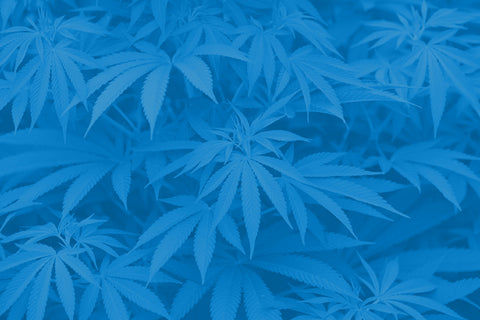
Cannabidiol (CBD) is certainly no longer the new kid on the block. In the last five years, it has exploded on the market in products that range from shampoos, skin creams, tinctures, suppositories, and (you've guessed it) troches!
So why is CBD use so widespread? And how the h*ll is it possible that the same compound can both heal your face and be inserted rectally to heal your prostate (if you have one) [9]?
Read on to learn CBD’s history, novel mechanisms of action, and amazing versatility!
Cannabidiol's History
The ingredients of the cannabis plant were first isolated during the 20th century. CBD in particular was studied from Minnesota wild hemp and Egyptian Cannabis indica resin. Its structure and stereochemistry was determined in 1963 by Dr. Rafael Mechoulam in Israel. In the 1980's, Dr. Mechoulam and his team did the first research on CBD for the treatment of epilepsy.
With the legalization of marijuana (which has THC, CBD, and many other minor cannabinoids in it) in several states in the late 1990’s and early 2000’s, researchers were able to expand cannabis research and CBD was studied as a remedy for chronic pain, epilepsy, and numerous neurodegenerative conditions.
The big shift, however, came in 2018 when the US passed a new Farm Bill making CBD derived from industrial hemp legal on a federal level. From there, the CBD gold rush was on.
Now CBD is everywhere and used for a wide variety of indications including chronic pain, inflammation, recovery, sleep, anxiety, and much more. Recently, the World Anti-Doping Agency removed CBD from their prohibited list, and many professional athletes use and market CBD as well.
How CBD Works
Did you know that you have a natural endocannabinoid system? Although it was named after the cannabinoids in cannabis and hemp plants, the body makes natural (endogenous) compounds that bind endocannabinoid receptors CB1 (mostly in your brain) and CB2 (mostly in your immune system). The two most common endocannabinoids are anandamide, known as our “bliss” hormone, and 2-arachidonoylglycerol (2AG).
CBD and other plant-derived cannabinoids (THC, CBG, CBN, and more) are classified as phytocannabinoids and they have various effects on the endocannabinoid system. THC, for example, acts on the CB1 and CB2 receptors and produces its famed psychoactive effects.
CBD, in contrast, is non-psychoactive and has low affinity for these receptors. Instead, it works indirectly on the endocannabinoid system by preventing the breakdown of FAAH (Fatty Acid Amine Hydrolase), an enzyme that breaks down anandamide.
Anandamide is a neurotransmitter that is derived from the polyunsaturated omega-6 fatty acid arachidonic acid (see, not all PUFAs are bad!). It gets its name from the word “ananda” which in Sanskrit means “happiness, pleasure, joy, and delight."
When anandamide binds to CB1 and CB2 receptors, it sends a message to calm down the firing of neurons that stimulate its release. This is called "retrograde signaling."
The release of anandamide is associated with decreased fear, anxiety, and inflammation... or said in reverse, more joy and more bliss! Anandamide is also neuroprotective and promotes neurogenesis (i.e., the growth of new nerve cells) [10].
CBD also acts on many non-endocannabinoid systems. Too high on THC? At low concentrations, CBD blocks the equilibrative nucleoside transport (ENT) leading to the direct enhancement of adenosine A1 receptors [1]. This mechanism is thought to be the reason that CBD has been found to counteract some of the effects of CB1 activation in the brain (from THC).
This is why cannabis users who use a higher ratio of CBD:THC strain/formula are less likely to have psychoactive effects compared to those who have a lower ratio of CBD:THC. CBD also enables users to tolerate a higher amount of THC since CBD counteracts its psychoactive effects.
At higher concentrations, CBD can activate the nuclear peroxisome proliferator-activated-receptor-γ, a transcription factor that governs the expression of genes involved in inflammation, redox equilibrium, insulin sensitivity, and the metabolism of lipids and glucose [1,8]. CBD also has a polyphenic nature, which is responsible for some of its antioxidant effects [1].
The precise mechanism of action that causes CBD to have its pain-alleviating effects is not well-known at the moment, but it is possible that a combination of the mechanisms explained above is responsible.
CBD Key Benefits
CBD has a number of key beneficial effects including:
- Reducing inflammation and pain [2]
- Decreasing anxiety [3]
- Improving sleep [4]
- Decreasing nausea and vomiting [5]
- Protecting the brain (neuroprotective) [6]
CBD Routes and Dosage
CBD is used in a variety of different ways, including but not limited to oral capsules, oils, creams, gummies, suppositories, and troches. CBD is now also regularly infused into food and beverages as well.
CBD clinical studies have shown efficacy over a wide dosing range — 400 mcg to 1000 mg depending on the indication. For anxiety, 300 mg of CBD significantly reduced symptoms, but there is evidence that even smaller doses can help, especially when combined with other compounds [7].
There are several factors to take into account when dosing CBD, including:
- Body weight
- Body composition
- Condition being treated
- Potency of CBD being ingested
- Other compounds being ingested with CBD
CBD’s half-life, when taken orally, is around 1 to 2 days [7]. This means if you ingest 100 mg of CBD, 50 mg will remain in your body after 1-2 days.
CBD Safety
While CBD is very popular to use, there are some side effects that have been reported, such as:
- Drowsiness
- Changes in mood or behavior
- Hypersensitive reactions
There have been some animal studies showing a possible link between astronomically high doses of CBD and liver damage, but the risk is very minimal if you are getting purity and potency tested products.
Conclusion
Here at Troscriptions, we currently use precision dosed and pure CBD isolates in three of our troches: Blue Cannatine, Tro Calm, and Tro Zzz.
In Blue Cannatine, CBD helps to soften the sharpness or edginess of the two stimulants in the formula: nicotine and caffeine. CBD likely accomplishes this by calming down the firing of neurons (retrograde signaling) and by increasing anandamide circulation. The end result? Instead of getting blasted off on a rocket ship with Blue Cannatine, it’s a smooth 15 to 30 minute ramp up to launch... followed by 3 to 5 hours of easy flow, massive productivity, sharper memory, and enhanced verbal fluidity with no come down or withdrawal.
In Tro Calm, CBD — in synergy with CBG, kava, and nicotinoyl GABA — decreases anxiousness, stress, and increases joy and bliss using the same mechanisms noted above. Tro Calm and Carry On!
And finally, in Tro Zzz, our sleep formulation, CBD modulates the endocannabinoid system by increasing the amount of anandamide available to help you fall asleep, stay asleep, and wake up refreshed!
References
- Devinsky, O., Cilio, M. R., Cross, H., Fernandez-Ruiz, J., French, J., Hill, C., Katz, R., Di Marzo, V., Jutras-Aswad, D., Notcutt, W. G., Martinez-Orgado, J., Robson, P. J., Rohrback, B. G., Thiele, E., Whalley, B., & Friedman, D. (2014). Cannabidiol: pharmacology and potential therapeutic role in epilepsy and other neuropsychiatric disorders. Epilepsia, 55(6), 791–802. https://doi.org/10.1111/epi.12631
- Russo E. B. (2008). Cannabinoids in the management of difficult to treat pain. Therapeutics and clinical risk management, 4(1), 245–259. https://doi.org/10.2147/tcrm.s1928
- Blessing, E. M., Steenkamp, M. M., Manzanares, J., & Marmar, C. R. (2015). Cannabidiol as a Potential Treatment for Anxiety Disorders. Neurotherapeutics : the journal of the American Society for Experimental NeuroTherapeutics, 12(4), 825–836. https://doi.org/10.1007/s13311-015-0387-1
- Whiting PF, Wolff RF, Deshpande S, Di Nisio M, Duffy S, Hernandez AV, Keurentjes JC, Lang S, Misso K, Ryder S, Schmidlkofer S, Westwood M, Kleijnen J. Cannabinoids for Medical Use: A Systematic Review and Meta-analysis. JAMA. 2015 Jun 23-30;313(24):2456-73. doi: 10.1001/jama.2015.6358. Erratum in: JAMA. 2015 Aug 4;314(5):520. Erratum in: JAMA. 2015 Aug 25;314(8):837. Erratum in: JAMA. 2015 Dec 1;314(21):2308. Erratum in: JAMA. 2016 Apr 12;315(14):1522. PMID: 26103030.
- Parker, L. A., Rock, E. M., & Limebeer, C. L. (2011). Regulation of nausea and vomiting by cannabinoids. British journal of pharmacology, 163(7), 1411–1422. https://doi.org/10.1111/j.1476-5381.2010.01176.x
- Fernández-Ruiz, J., Sagredo, O., Pazos, M. R., García, C., Pertwee, R., Mechoulam, R., & Martínez-Orgado, J. (2013). Cannabidiol for neurodegenerative disorders: important new clinical applications for this phytocannabinoid?. British journal of clinical pharmacology, 75(2), 323–333. https://doi.org/10.1111/j.1365-2125.2012.04341.x
- Larsen, C., & Shahinas, J. (2020). Dosage, Efficacy and Safety of Cannabidiol Administration in Adults: A Systematic Review of Human Trials. Journal of clinical medicine research, 12(3), 129–141. https://doi.org/10.14740/jocmr4090
- https://www.ncbi.nlm.nih.gov/pmc/articles/PMC6037317/
- https://www.webmd.com/a-to-z-guides/news/20190624/cbd-as-a-superbug-antibiotic
- https://www.ncbi.nlm.nih.gov/pmc/articles/PMC4543605/





Comments (0)
There are no comments for this article. Be the first one to leave a message!